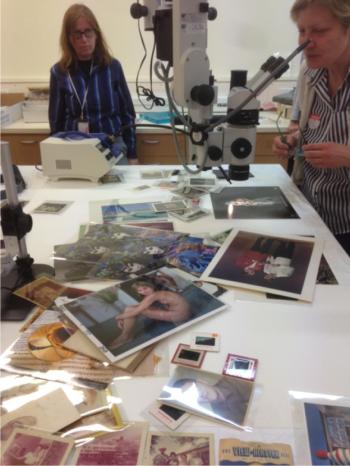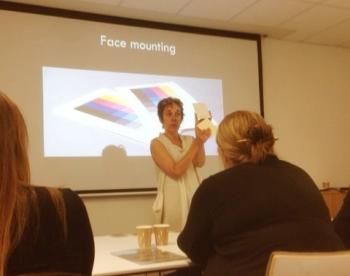

Preserving contemporary photography

Conservator Shingo Ishikawa and Audiovisual Co-Assistant Kerry Yates recently attended a series of workshops run by Sylvie Penichon, from the Amon Carter Museum of American Art in Fort Worth, Texas.
The workshops were part of a photographic conservation conference presented by the American Institute for Conservation of Historic and Artistic Works (AIC) and the International Council of Museums – The Committee for Conservation (ICOM-CC) in Wellington, New Zealand, in early March 2013.
In this blog post, Shingo and Kerry share their impressions and some of the lessons learned.
I was fortunate to be able to join a very small group of people for the all-day workshop run by Sylvie Penichon on History, Identification and Preservation of 20th Century Colour Photographs. It was a perfect way to start a very busy week in the beautiful city of Wellington.
20th century colour photography is such a vast field, so there was a lot of information to absorb. It is particularly relevant to the NFSA because most of our photographic collection falls into this category.
The workshop started with a session on colour theory and colour photographic techniques from both the 19th and 20th centuries, including their physical make-up, characteristics, identification and preservation needs and common deterioration.

After a much needed lunch break, we went down to the paper conservation lab at the Museum of New Zealand Te Papa Tongarewa to put what we learnt into practice. Three stations were set up to practise our identification skills and to try out cleaning methods with different solvent types, as well as retouching of chromogenic materials using water colours and a commercially available Kodak retouching kit to compare the results.
We split into three groups and spent about 30 minutes on each station. After the practical session, we all gathered together on the identification table to discuss our thoughts about each print.
I particularly enjoyed having the hands-on session with different types of 20th century colour photographs right after the lecture to try to consolidate what we have learned. This is a field where technology is being developed much quicker than we could study. We always seem to be playing catch up with the technology, which becomes obsolete so quickly.
Shingo Ishikawa
I attended Sylvie Penichon’s Contemporary Photography: Techniques and Preservation workshop on the second day of the conference. The workshop was divided into three sections:
Printing processes – terminology, characteristics and identification
Conservators have the challenge of keeping up with digital printing technology – inks, papers and printing. How do you conserve these prints for the future?
Digital printing processes are rapidly evolving and there are many different types, such as chromogenic, silver dye-bleach, dye diffusion, continuous inkjet, and drop-on-demand inkjet. Inks can be UV curing, solid, or based on dye, pigment, water, solvent, or oil. Paper, on the other hand, ranges from bond to art paper, and inkjet to coated inkjet. It is impossible to test every combination for print permanence!
To complicate matters further, there is no standard terminology in use, and artists are experimenting with various techniques and methods in their prints. For example, artists Ackroyd & Harvey create photosynthesis images on grass.
Sylvie recommended using a standardised questionnaire when acquiring photographic works into your collection to gather as much information as possible, such as this form endorsed by The American Institute for Conservation and its Photographic Materials Group.

Mounting and finishing techniques and materials
Prints are getting bigger and it is more difficult to keep them flat, uncreased and undamaged.
Mounting keeps prints flat and protected from damage. There are many mounting substrates, and what you choose may affect the long-term stability of the artwork. You must ask yourself, face mounting or laminating? There are five categories of laminates. Do all mounting materials pass the Photographic Activity Test (PAT)? Again there are many, many choices.
Storage, housing and exhibition guidelines
Environmental conditions need to be monitored; therefore, conservators must choose appropriate storage materials and enclosures.
The conclusion is that artistic prints are getting larger, which poses problems for mounting, installation and storage, and processes are becoming obsolete fairly rapidly. This can make it difficult to keep up with the knowledge that is required so that preservation needs can be understood.
For conservators to make informed decisions about the preservation requirements for photographic collection items, it is important to keep up with digital processing and differing terminologies used in digital photography, and when acquiring photographic images into your collection it is important to get as much information as possible from the artist about their photographic work.
Kerry Yates
The National Film and Sound Archive of Australia acknowledges Australia’s Aboriginal and Torres Strait Islander peoples as the Traditional Custodians of the land on which we work and live and gives respect to their Elders both past and present.